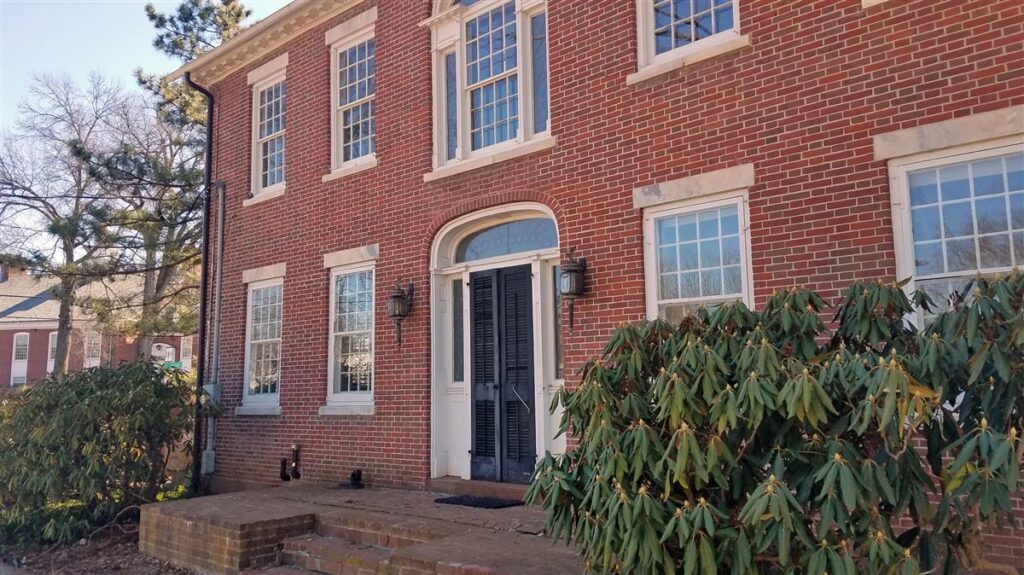
By Richard N. Pierce
Wintonbury Historical Society
Since construction has started on the new apartments adjacent to the Roberts House on Bloomfield Avenue, some are wondering about the fate of that historic brick structure, which adds so much to the ambiance of Bloomfield Center. Over Tunxis Trails, a publication of the Wintonbury Historical Society, says:
“Of all the structures that once encircled the green, the only two remaining are the Congregational Church and the Roberts’ Homestead at 717 Bloomfield Avenue, which faces north. This Federal-style brick house built in 1822 by Lemuel Roberts has a beautiful front entrance door featuring a large Palladian window overhead and leaded-glass side windows. Some old records indicate that the exterior of the main part of the house is built of the small Dutch bricks brought from Holland as ballast in old sailing vessels although this has been disputed. The house remained in the Roberts family for 115 years prior to its purchase in 1937 by Dr. Donald and Margaret McCrann, and it is often referred to as the McCrann House.” (page 8)
The McCrann family sold the house to Thomas Farnham in 2000, and businessman Paul Butler bought it in 2018. Butler appeared before the Town Plan and Zoning Commission on May 23, 2019 and assured the Commission that he fully intends to preserve the building. According to Jose Giner, Director of Planning and Economic Development for the Town of Bloomfield, Butler has stated on the record that he has no plans to demolish or otherwise change the appearance of the house. He has stated that he is sensitive to historic preservation and personally maintains a historic house on Cape Cod that he restored. Butler, the developer of the Heritage Flats Apartments, stated that he would use the house as offices for his business and for the Chamber of Commerce. He anticipates having three employees in the house. Butler’s company has recently broken ground for the construction of new apartments on the plot just to the south of the Roberts House, adjacent to the office complex on Barnard Lane.
Not only is the house itself historic, but for many years the Roberts family was an important part of the Bloomfield community. In 1776, Captain Lemuel Roberts led nine men from Wintonbury in answering the Lexington Alarm. Lemuel Jr., variously known as Esquire, Judge, and Captain, supplied food and equipment to troops during the Revolutionary War. Lemuel III married Roxy Gillette, daughter of Amos and Susannah Gillette. One of their sons, Hiram, owned a store near the town green and was Bloomfield’s first representative to the General Assembly. Hiram’s brother, Lemuel IV, married Betsey Thrall. In 1841, their son, James W. Roberts, became president of the newly organized temperance society (whose members included Jay Filley and Francis Gillette). About 1889 Lester Roberts (James’ brother) gave the town $100 for making a park between the Roberts homestead and the Congregational Church (today’s town green). Ella Roberts Wood, James’ daughter, who grew up in the homestead, gave one of the principal talks at the dedication of the new Prosser Library in 1903.
The Roberts house was built in 1822 when Lemuel III was 56 and his son Lemuel IV was 33. It is uncertain which of them built the house; but, considering that Lemuel III’s five children were ages 22-35 that year and Lemuel IV’s four children were ages 5-12, it would seem that Lemuel IV had greater need of a new house.
If Lemuel Roberts IV built the house, he lived there only a few years, for he died at age 36 in 1825. His widow, Betsey, the daughter of Oliver Thrall and Wealthy Latimer, had brought two well-known Bloomfield surnames into the Roberts clan. Other Roberts sons were to marry into such Bloomfield families as the Beamons, Battersons, Bidwells, Burnhams, Gillettes, and Woodfords, among others.
The Roberts House embodies a lot of Bloomfield history and should have legal protection that goes beyond oral agreement. As preservationist Ann Street has said, historic buildings are the embodiment of a community’s history and part of a broad public trust. The loss of such structures has an adverse impact on the quality of life for the whole community. It is appropriate—essential, even—that the town council be involved whenever the continuance of a historic property becomes uncertain.
Adoption of a Delay of Demolition ordinance would protect historic buildings from being torn down without due process. Such an ordinance would establish specific and easily verifiable criteria to determine which buildings were considered historic. The ordinance would encourage dialogue between parties (such as developers and preservationists), avoiding an adversarial relationship and aiming for a win-win solution. Those who object to demolition would suggest alternative plans. As Ann Street said, merely preventing demolition does not save buildings. It is people who save buildings by using and maintaining them.
It may not be feasible for the Roberts House to continue as a dwelling today, but it can be repurposed and maintained as an integral part of the center of town. In that way we can affirm the character of our town and its distinctive history. Then all townspeople may share in that heritage.


